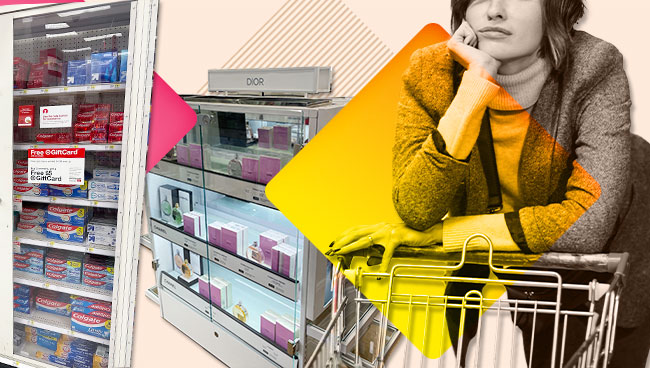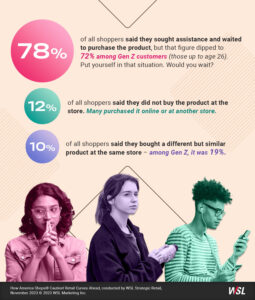Major retailers, including Target, Walmart, CVS and Walgreens, have been locking up categories of products behind theft-proof barriers. But their efforts to prevent theft might cost more than the shrink they’re trying to prevent. Our new How America Shops® research into product lock-downs, and how different generations respond, reveals the breaking points.
Here’s How To Unlock a Happy Customer Experience
Merchandise is under siege, and many consumers are paying the price in convenience.
Across the country, retailers are locking up more product categories to protect them from theft. Our research found it is not limited to urban markets; shoppers in the suburbs also encounter locked merchandise.
An industry survey by the National Retail Federation, released in September, shows the annual shrink rate, including external and internal theft, rose to 1.6% in 2022 from 1.4% in 2021. In dollars, that shakes out to $112 billion in losses in 2022, from $94 billion in 2021 (inflation may contribute to the figure).
To counter theft, many stores across the country are protecting products behind lock-and-key structures that require a sales associate, with the right key, to unlock the merchandise. This is contrary to the fast, easy shopping customers expect today.
In doing so, retailers also are locking out sales, according to the results of our new How America Shops® research report, “Caution! Retail Curves Ahead.”
Most Shoppers Had to Choose Whether to Ask for Help
Seven in 10 shoppers across the U.S. told us that they have encountered situations in stores where they wanted to buy a product that was locked behind a case and required a sales associate to unlock the product. So they had to make a choice. Here’s what they chose to do on the last time they faced this situation:
They Sought Assistance Last Time. But What About Next Time?
So, 22% of shoppers either changed products or skipped the purchase because the item they wanted was locked up. That might seem like a small share, but here’s the thing – this was just on the last occasion. When we asked these deterred customers why they didn’t seek help, their answers indicate that on repeat occasions, other shoppers could turn away as well.
Customers didn’t seek assistance to purchase locked-up goods because:
- The majority didn’t ask for assistance because they wanted to avoid the hassle.
- Many couldn’t find store personnel to help and when they did, the employee had trouble unlocking the case.
- One-third were frustrated the products were locked up. Imagine how many minutes this adds to a “quick” shopping trip.
- One-quarter said they did not have the time to wait.
Shoppers have told us repeatedly in our How America Shops® studies that saving time and reducing stress are top on their lists when choosing where to shop for the basics. Locked merchandise adds both stress and time to a trip. Retailers’ shouldn’t expect their customers to get used to locked merchandise, because shoppers have other options to get their goods.
Finding a Solution That Doesn’t Disrupt the Shopping Trip
At some point, retailers will have to balance the logic of merchandise lockup against a trouble-free shopper trip, specifically regarding higher-frequency products that their customers expect to access without seeking permission. It’s one thing to protect medications because they can be misused or easily put in a pocket, but laundry detergent? It’s counter-intuitive to easy shopping.
Here are some suggestions on how to strike that balance, based on our customer-informed insights.
- Staff the store to unlock sales. 47% of shoppers define ease as being able to get in and out of the store quickly. Looking for an employee to unlock a case takes time. Shoppers are more likely to ask for help if they can see nearby workers who are clearly assigned to do so. (See our How America Shops® “Paradox of the New Shopping World” for more.)
- Alert shoppers in advance. If retailers take the surprise out of lockups, through in-store and online messaging, shoppers can factor the disruption into their trips. This should reduce frustration. Messaging could also explain the effects of theft and include alternate purchase options, such as buying online at the retailer’s site and “subscribe and save” fulfillment. Online, messaging can suggest shoppers order the merchandise in advance and pick it up at the store’s pickup site or curbside.
- Post online purchase options at the case, as well. Of the shoppers who chose to order products online rather than seek assistance, more were Millennials and Gen X. However, consumers of any age might choose to online-order a locked-up product if a QR code or the store’s website is posted on the case. Doing so improves the chances of the retailer keeping that sale, rather than losing it to a competitor.
- Most importantly, retailers need to think like their customers. What would encourage shoppers to ask for help without frustration? How can they get what they want faster? Because paying customers shouldn’t have to cover the price of theft. Many won’t. One-third of the shoppers who encountered locked-up merchandise told us they are less likely to shop the same retailer again. Retailers need to encourage store traffic; not put up obstacles.
If you’re concerned about theft, rising prices and other events that are altering your shoppers’ paths, we might have the research to help, here. If you want tailored insights into how your customers are responding to changes in your stores, ask about a consultation.



